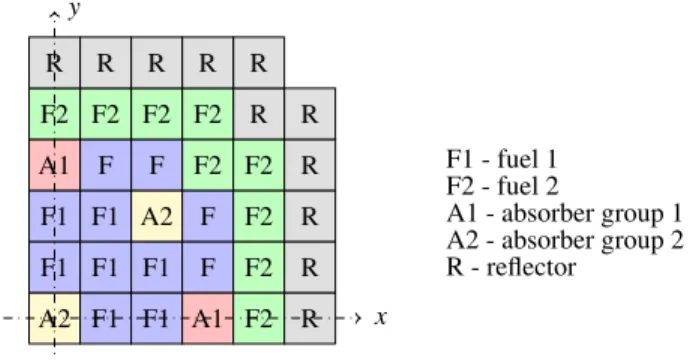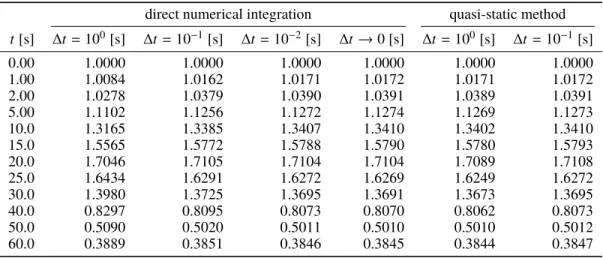HAL Id: hal-02411091
https://hal.archives-ouvertes.fr/hal-02411091
Submitted on 16 Dec 2019HAL is a multi-disciplinary open access archive for the deposit and dissemination of sci-entific research documents, whether they are pub-lished or not. The documents may come from teaching and research institutions in France or abroad, or from public or private research centers.
L’archive ouverte pluridisciplinaire HAL, est destinée au dépôt et à la diffusion de documents scientifiques de niveau recherche, publiés ou non, émanant des établissements d’enseignement et de recherche français ou étrangers, des laboratoires publics ou privés.
Development of quasi-static capabilities for
corpus-APOLLO3
D. Caron, A. Calloo, Jc. Lepallec, C. Patricot
To cite this version:
D. Caron, A. Calloo, Jc. Lepallec, C. Patricot. Development of quasi-static capabilities for corpus-APOLLO3. International Conference on Mathematics and Computational Methods applied to Nuclear Science and Engineering (MandC 2019), 2018, Unknown, Unknown Region. �hal-02411091�
DEVELOPMENT OF QUASI-STATIC CAPABILITIES FOR
CORPUS-APOLLO3
®D. Caron, A. Calloo, J.-C. Le Pallec, and C. Patricot
Commissariat à l’énergie atomique et aux énergies alternatives CEA, Université Paris-Saclay, F-91191 Gif-sur-Yvette, France
dominic.caron@cea.fr, ansar.calloo@cea.fr, jean-charles.le-pallec@cea.fr, cyril.patricot@cea.fr
1. INTRODUCTION
The current trends of computational analyses of nuclear reactor dynamics in normal, incident and accident scenarios are characterised by the desire to model the relevant physical phenomena with increasing accuracy and to remain within practical limits of computational time. Considering the implications on the modelling of neutronics, it is understood that phase-space-dependent neutron kinetics is necessary in order to achieve the requirements on accuracy. However, the solution of the neutron and delayed neutron precursor balance equations by means of the traditional approach of direct numerical integration contributes significantly to the computational burden, which is a consequence of the large number of unknowns and the time-stiffness of the system of balance equations.
Motivated by these considerations and as part of a preliminary study of methods by which to solve the time- and phase-space-dependent neutronics equations in the context of multi-physics analyses, a recent activity of the Commissariat à l’énergie atomique et aux énergies alternatives (CEA) involves the development of quasi-static capabilities for the neutronics code APOLLO3® ∗ [1, 2] and making them available to the multi-physics simulation tool CORPUS [3]. As the quasi-static approach is based upon the decoupling of the evolution of the amplitude and the shape components of the neutron flux, it permits to decrease the computational burden in the analysis of transients where the two quantities evolve according to significantly different time scales.
The present work describes the development and the implementation of the quasi-static method in the framework of CORPUS-APOLLO3®. This paper focuses on the description and the validation of the mathematical methods that are selected for implementation in order to solve the neutron and delayed neutron precursor balance equations according to the quasi-static approach in the absence of multi-physics considerations. Instead, the development and the analysis of an algorithm for the multi-physics coupling of the quasi-static method described herein and the application to multi-physics problems is addressed in a companion paper [4].
2. PHYSICAL-MATHEMATICAL MODEL
The time-dependent neutron transport equation and delayed neutron precursor balance equations may be written as [5] 1 v(E) ∂ ∂tφ(r, E, Ω, t) = " H − R Õ r=1 χr 4πFr ! φ # (r, E, Ω, t) + R Õ r=1 χr(r, E) 4π λrcr(r, t), ∂ ∂tcr(r, t) = [Frφ](r, t) − λrcr(r, t), r = 1, . . . , R, (1)
with φ the neutron flux, cr the concentration of delayed neutron precursors in decay family r, v the neutron velocity, H the superposition of the operators that describe neutron loss, scattering and production in fission and Fr, χr and λr representing the operator for delayed neutron generation, the emission spectrum and the decay constant, respectively, of delayed neutron precursor family r. Following the approach of Henry [6], the flux is factorised into the product of a time-dependent amplitude function, T , and a time- and phase-space-dependent shape function, ψ,
φ(r, E, Ω, t) = T(t)ψ(r, E,Ω,t). (2) The factorisation is rendered unique by imposing the normalisation requirement
φ† 0(r, E, Ω), 1 v(E)ψ(r, E, Ω, t) = γ0 ∀t, (3)
with φ†0 the adjoint solution of the steady-state form of Eqs. (1), γ0 an arbitrary constant and the notation h·, ·i indicating the scalar product of the arguments on the phase-space. These specifications permit to arrive at the system of balance equations for the amplitude
d dtT (t)= " ρ(t) Λ(t) − R Õ r=1 e βr(t) Λ(t) # T (t)+ R Õ r=1 λrecr(t), d dtecr(t)= e βr(t) Λ(t)T (t) −λrecr(t), r = 1, . . . , R, (4)
with the effective generation time Λ, the dynamic reactivity ρ, the effective delayed neutron fractions e
βrand the effective delayed neutron precursor concentrationsecr given by their usual definitions [6]. Newly developed functionalities of the code APOLLO3® permit to compute the integral kinetics parameters (Λ, ρ and eβr) in a manner that is consistent with the discretisation schemes applied to the phase-space variables in the selected solver of the flux. Similarly, a newly developed point-kinetic module allows to solve the system of balance equations for the amplitude, Eqs. (4), under the hypothesis of a polynomial variation of the ratios ρ/Λ and eβr/Λ on the time step in consideration. The point-kinetic solver is based on the method of Rosenbrock [7] of order 4(3) and includes an adaptive time-step selection algorithm that permits to respect a user-imposed limit on the integration error. At present, the temporal evolution of the shape is managed according to a predictor-corrector approach [8], which permits to employ the existing direct numerical integration techniques of the code APOLLO3®[9], namely those to solve Eqs. (1), together with the normalisation, Eq. (3), in order to determine the shape at any discrete point in time.
Further details of the parametrisation of the integral kinetic parameters and the mathematical methods employed in the solution of the amplitude, the shape and the delayed neutron precursor balance equations will be provided in the full paper.
3. APPLICATIONS AND RESULTS
In order to demonstrate the quasi-static capabilities, the three-dimensional delayed critical transient of [10] is analysed. A cross-sectional, quarter-core view of the geometry of the system is shown in Fig. 1. The materials are described by two neutron energy groups and six delayed neutron precursor families, both of which are typical of a light-water reactor. The transient is defined by the extraction of absorber group 1 (which is initially inserted) on the interval 0–26.6 s and the insertion of absorber group 2 (which is initially extracted) on the interval 7.5–47.5 s; both absorber groups move at circa 3 cm/s. Precise and complete details of the geometry, the materials and the transient definition may be obtained from the reference [10].
A2 F1 F1 F1 F1 F1 A2 F1 F1 A1 F F F2 F F A1 F2 F2 F2 F2 R F2 F2 F2 F2 R R R R R R R R R R x y F1 - fuel 1 F2 - fuel 2 A1 - absorber group 1 A2 - absorber group 2 R - reflector
Figure 1: Planar view of the geometry of the system considered for the transient.
Selected results are provided for computations performed with the MINOS solver [11] in the diffusion approximation using Raviart-Thomas-Nédélec finite elements of order 1 and a uniform spatial mesh of 5 cm. The time-dependent behaviour of the integral power is presented in Table 1 for two methods of temporal integration: direct numerical and quasi-static. The direct numerical integration employs a theta-method using a value of θ = 1 for reasons of stability necessitated by the relatively large values of the time-steps and the results serve to provide a reference by means of the extrapolation of calculations made with three different time-steps. The quasi-static integration utilises the same value of θ when solving the flux equations (from which the shape is extracted) and a single reactivity time step per shape time step (i.e. the integral kinetic parameters are parametrised only once on the shape time step). In comparison to the results obtained by direct numerical integration, the developed quasi-static method provides an accurate solution with a shape time-step that is orders of magnitude greater than the flux time-step which would produce a solution of equivalent accuracy by the method of direct numerical integration.
In the manuscript, it is foreseen to provide a thorough examination of the behaviour and the performance of the developed quasi-static method by means of additional parametric studies and the inclusion of complementary results.
Table 1: Relative total power as a function of the time-step and the method of integration for the transient (∆t = ∆tρ = ∆tψ, with the flux time-step ∆t, the shape time-step ∆tψ and the
reactivity time-step ∆tρ).
direct numerical integration quasi-static method t[s] ∆t = 100[s] ∆t = 10−1[s] ∆t = 10−2[s] ∆t →0 [s] ∆t = 100[s] ∆t= 10−1[s] 0.00 1.0000 1.0000 1.0000 1.0000 1.0000 1.0000 1.00 1.0084 1.0162 1.0171 1.0172 1.0171 1.0172 2.00 1.0278 1.0379 1.0390 1.0391 1.0389 1.0391 5.00 1.1102 1.1256 1.1272 1.1274 1.1269 1.1273 10.0 1.3165 1.3385 1.3407 1.3410 1.3402 1.3410 15.0 1.5565 1.5772 1.5788 1.5790 1.5780 1.5793 20.0 1.7046 1.7105 1.7104 1.7104 1.7089 1.7108 25.0 1.6434 1.6291 1.6272 1.6269 1.6249 1.6272 30.0 1.3980 1.3725 1.3695 1.3691 1.3673 1.3695 40.0 0.8297 0.8095 0.8073 0.8070 0.8062 0.8073 50.0 0.5090 0.5020 0.5011 0.5010 0.5010 0.5012 60.0 0.3889 0.3851 0.3846 0.3845 0.3844 0.3847 REFERENCES
[1] H. Golfier et al. “APOLLO3 : a common project of CEA, AREVA and EDF for the develop-ment of a new deterministic multi-purpose code for core physics analysis.” In: M&C 2009. Saratoga Springs, New York, USA, 3–7 May 2009 (2009).
[2] D. Schneider et al. “APOLLO3® : CEA/DEN deterministic multi-purpose code for reactor physics analysis.” In: PHYSOR 2016. Sun Valley, Idaho, USA, 1–5 May 2016 (2016). [3] J.-C. Le Pallec, K. Mer-Nkonga, and N. Crouzet. “Neutronics / fuel thermomechanics coupling
in the framework of a REA (rod ejection accident) transient scenario calculation.” In: PHYSOR
2016. Sun Valley, Idaho, USA, 1–5 May 2016 (2016).
[4] D. Caron et al. “Analysis of methodologies for the coupling of multi-physics phenomena in the quasi-static approach to nuclear reactor dynamics.” In: Submitted to M&C 2019. Portland, Oregon, USA, 25–29 August 2019 (2019).
[5] G. Bell and S. Glasstone. Nuclear reactor theory. Van Nostrand Reinhold, New York, New York, USA (1970).
[6] A. F. Henry. “The application of reactor kinetics to the analysis of experiments.” Nuclear
Science and Engineering, 3(1): pp. 52–70 (1958).
[7] H. H. Rosenbrock. “Some general implicit processes for the numerical solution of differential equations.” The Computer Journal, 5(4): pp. 329–330 (1963).
[8] S. Dulla, E. H. Mund, and P. Ravetto. “The quasi-static method revisited.” Progress in Nuclear
Energy, 50(8): pp. 908–920 (2008).
[9] A. Kavenoky and J.-J. Lautard. “The neutron kinetics and thermal-hydraulic transient com-putational module of the NEPTUNE system : CRONOS.” In: NRC meeting on advances
in reactor physics and core thermal hydraulics, (pp. 781–792). Kiamesha Lake, New York, USA, 22–24 September 1982 (1982).
[10] S. Langenbuch, W. Maurer, and W. Werner. “Coarse-mesh flux-expansion method for the anal-ysis of space-time effects in large light water reactor cores.” Nuclear Science and Engineering,
63(4): pp. 437–456 (1977).
[11] A.-M. Baudron and J.-J. Lautard. “MINOS : A simplified Pn solver for core calculation.”

